Waterfront property in San Diego can rent for thousands of dollars a month — and costs millions if you’re looking to buy. But on one small island, in the middle of the San Diego River, about 15 residents get their own slice of nature by paying what some call “island rent.” And here, the rent is due every day.
It comes down to keeping personal areas clean, lending a helping hand and sharing provisions — “Don’t be greedy,” as one resident puts it.
“I love the peace of it,” said 50-year-old Jerrod Starbird. He has spent close to a year living in a tent on the island with his girlfriend, Tia, and 2-year-old Boxer mix named Proper. “I just saw some ducks surfing the rapids over there. That was pretty cool. That was probably the highlight of my day.”
But life on this island is harsh and unforgiving. Residents have to carry food, water and other supplies through a river that can be waist high and brimming with hazardous bacteria. A thriving rat population chews through tents, clothing and food. A busy thoroughfare passes directly overhead, producing a constant echo from traffic noise bouncing off the water. And the people living here are desperate for a better alternative.
“It’s a nice place to visit; don’t want to live here,” Starbird said, adding that he hopes to find housing soon. “It’s a nightmare.”
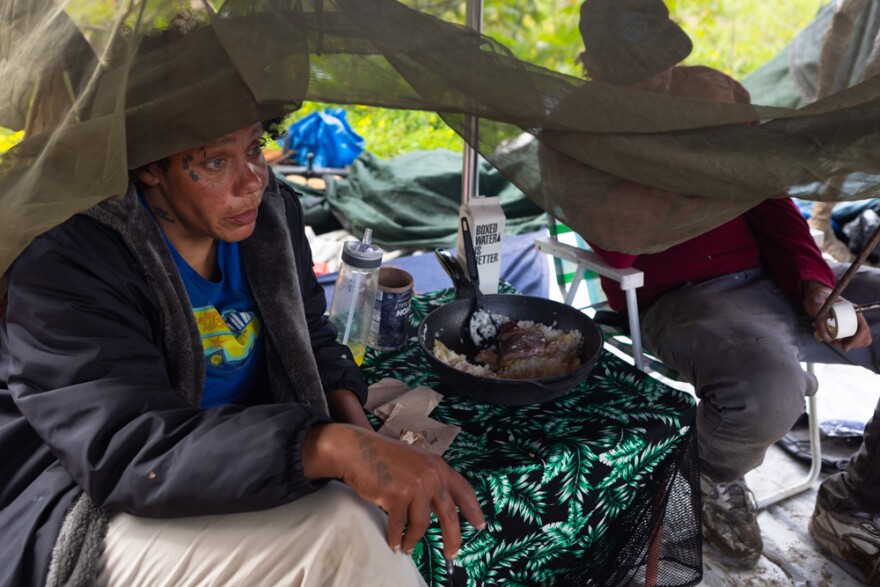
It’s also illegal. The residents on this island are part of a growing trend of unhoused people flocking to canyons and riverbanks to lay low and avoid detection in the wake of a controversial ban on camping in public. Narrowly passed by the City Council last June, the law makes it illegal to camp citywide if shelter beds are available, and anytime, regardless of shelter availability, near schools, parks, transit hubs and waterways.
It has had a significant impact. The number of people sleeping on downtown sidewalks has been cut in half compared to this time last year. Since enforcement began, San Diego police have issued 50 citations and made six misdemeanor arrests for unauthorized camping. Cities across San Diego County are drafting similar bans. A statewide proposal has stalled for now.
But the approach is not solving the problem. Every month for the past two years, more people in San Diego County have lost housing than those who manage to find it. Those who want shelter often can’t get it — though Mayor Todd Gloria hopes to solve that problem by transforming an old warehouse into a 1,000-bed shelter.
Data and interviews reveal the city’s camping ban has pushed people without housing into more remote, harder to reach areas — away from the services and help they need to get back into housing. The riverbed alone has seen nearly twice as many people asking for help since the ban took effect, according to data from PATH, a homeless service provider.
Janis Wilds, an outreach specialist with Housing 4 the Homeless, said it’s exactly what critics of the camping ban predicted. Homelessness isn’t going away, Wilds said, people are just being pushed around.
“They have to stay moving all day because the police hassle them if they stop anywhere,” she added. “That’s why people are going to the riverbed.”
Nestled at the bottom of a floodplain in a narrow corridor, surrounded by dense urban development and high-speed roads, this one particular island in the river is a unique place to call home. It’s really a peninsula during low tide and an island during high tide. Rain washes fertilizer and pesticide from landscaping, vehicle fluid from roadways, and bacteria from feces and urine, flushing it all into the river. And it floods regularly, sweeping tents, trash and people away.
But what makes this island so attractive, several residents said, is that “the cops don’t come around.” That’s because it’s just outside San Diego police jurisdiction.
“I’m tired of being messed with,” said a man who goes by Guido. inewsource agreed to not name him over concerns of retaliation.
He and his partner, Sarah, moved out to the island less than a year ago to avoid contacts with police. He said he’s out of prison on parole and doesn’t want to go back. Until they find a better indoor option, Guido said this is the best place for them. Out of sight, out of mind, he said.
“It comes to a point, a boiling point, you just get tired of it,” he added. “Tired of being sick and tired.”
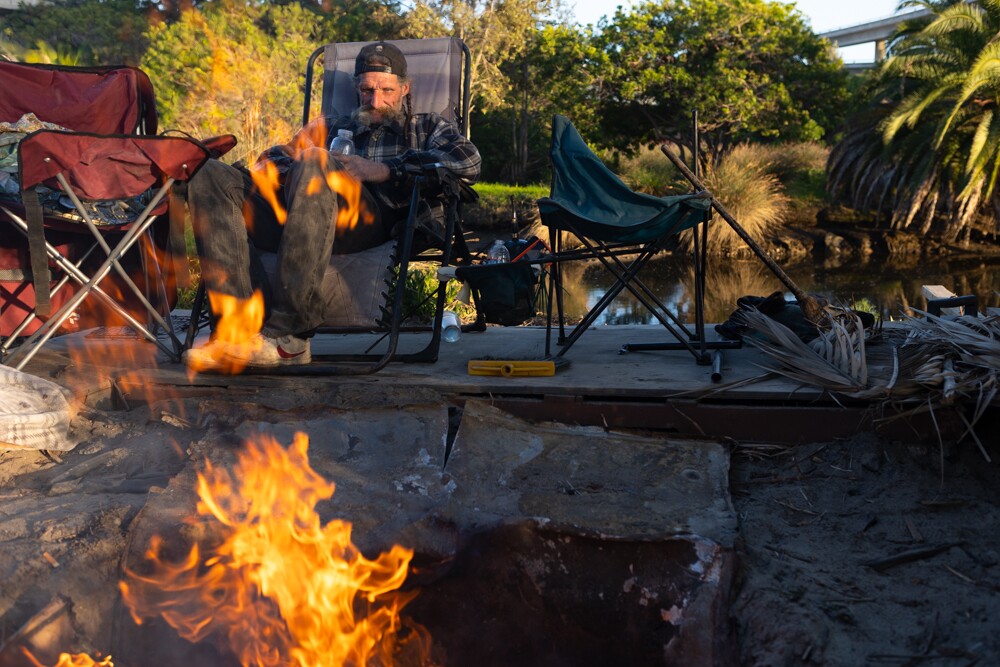
Change may be coming soon, though. Last month, the San Diego City Council agreed to spend a $3.7 million grant on outreach and rental subsidies for people living in the riverbed. Homeless service providers will ramp up efforts to help these folks beginning May 1.
When the City Council met last month to accept the grant, Councilmember Jennifer Campbell praised city staff’s efforts to reduce the number of unsheltered residents living downtown, but expressed doubts about their ability to replicate that success in the riverbed.
“I think the riverbed is an even more difficult task to clear out. I happen to know one person who is living there who loves it and will not leave it. So,” she said, sucking her teeth and chuckling, “best wishes. But thank you so much for trying.”
Striking a balance in a desperate situation
Starbird is wet from the waist down. He had just returned to the island from a nearby food pantry, where he goes once a week to pick up staples. He said every Monday he hopes to find some kind of meat, but often only walks away with peanut butter, rice and beans.
“That’s alright, it’s something,” Starbird says with a laugh.
But on this particular Monday, he’s in pain. As much as he loves being on the island, surrounded by water, he knows it can be toxic. He has evidence of it on his right leg. He pulls his pants down — “Don’t worry, I’ve got underwear on,” he said — and reveals an inflamed, festering skin infection that covers about six inches of his knee. It’s red and puffy, and purple in some places.
“It’s very painful, extremely sensitive. Normally, I’ve got a pretty good tolerance toward pain,” Starbird said. “This stuff hurts.”
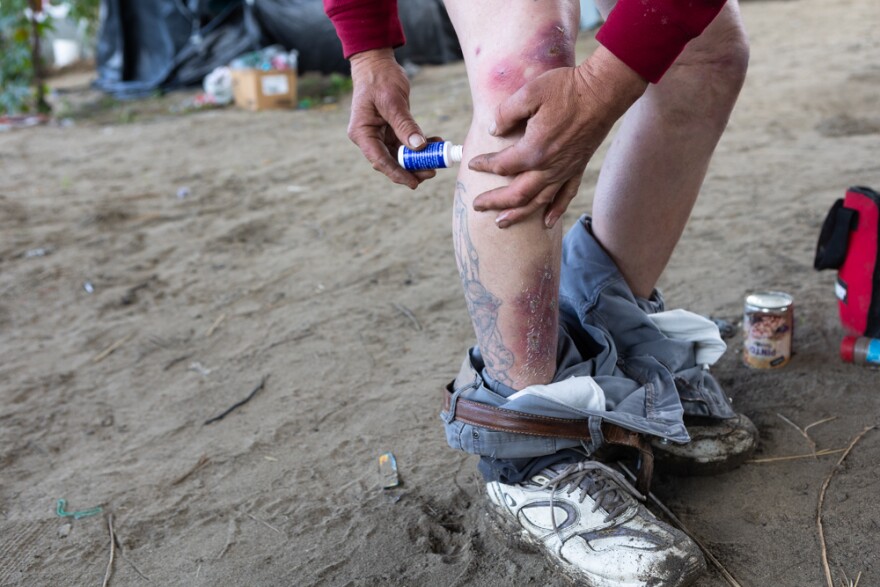
It started with a small puncture from one of the many bushes of spear grass on the island. And constantly walking through the river, as he just did on his return from the food pantry, has caused an infection. He said he poured some bleach on it to see if it would clear up. If it doesn’t, he’ll go to the hospital. It’s a price he’s willing to pay to stay away from police — at least until he finds a better option.
“I don’t really like living out here; I don’t want to die out here,” he said. “This is not for me. I’m more of an indoorsy, turn the lights on, go to the bathroom, close the door, you know what I mean?”
Starbird said he hopes to connect with PATH and find housing soon.
“I would love to get a job,” he said. “I would love to pay my own way in life again.”
There’s a common misconception that many people living in the riverbed don’t want help, said Kendall Burdett, an outreach specialist with PATH. His area of focus is the riverbed, from the ocean to Mission Trails.
Burdett said he often hears people say, “There’s probably a lot of people that want to be out there.”
“That’s not correct at all,” he said. “I have yet to come across somebody that’s experiencing homelessness that does not want help and wants to be left alone.”
People don’t move to the riverbed because they want to be there, Burdett said. They’re trying “to avoid detection, to avoid victimization, to avoid getting robbed, attacked, abated — you name it.”
People remain there because interventions typically have not worked. But these are environmentally vulnerable areas that can be hazardous to health and safety. The key is striking a balance between preserving these areas, while also finding the best fit for people so they don’t want to come back, he said. For many folks living in the riverbed, they’ve been outside so long that a typical indoor congregate shelter may not work for them.
“Just because there’s a roof over someone’s head doesn’t mean it’s the best placement for them,” Burdett said.
He has 65 people on his caseload — 40 of them are active, meaning they’re regularly keeping in contact and showing up for appointments. The problem is, it takes about two months on average, from the first point of contact until they find temporary shelter or long-term housing. The city just doesn’t have enough affordable and appropriate housing to keep up with demand, he said.
“Some people have expressed great trepidation about accepting help because they don’t want to be let down,” Burdett said. “They don’t want a reason to get their hopes up and then have the ball dropped either on our side or on their side.”
Once they find the right fit, he said, everything else falls into place.
“We have low recidivism, meaning once somebody is housed, they stay housed and they don’t return back to the riverbed.”
Home is where you make it
In many ways, the island is a microcosm of almost any neighborhood in San Diego.
Residents have created something that resembles a mixed-use development among cottonwood willow trees, wildflowers and a flourishing bird habitat. There are small standalone tents, tents pushed together to form what looks like multi-family housing, and a large tent with a camouflage tarp that doubles as a cigarette stand.
On the southwest corner of the island, surrounded by rows of tall Spanish cane, there’s a dirt path lined with bicycle rims that leads to Art’s place.
“I call it my bungalow,” Art said with a chuckle and a wave toward his “humble abode.”
It’s a tent erected in the trees, tucked away from others in what almost feels like a cul-de-sac. The outside decor represents a kind of grungy, eclectic bohemian vibe — with old bike chains and gears, playing cards, a license plate, a Honda emblem and a peace sign.
There’s a toy airplane hanging from the trees above, while other trees are adorned with a stuffed teddy bear and a giant fake spider — the kind of thing a Halloween supply store keeps on hand. A 15-foot flag is planted in the ground close by, bearing the insignia of a skull and crossbones — except the bones are actually water pipes, also known as bongs.
Inside, his tent is painted to resemble a castle with a dragon rearing its head through a window. A disco ball made of welded-together skeleton keys hangs from the ceiling.
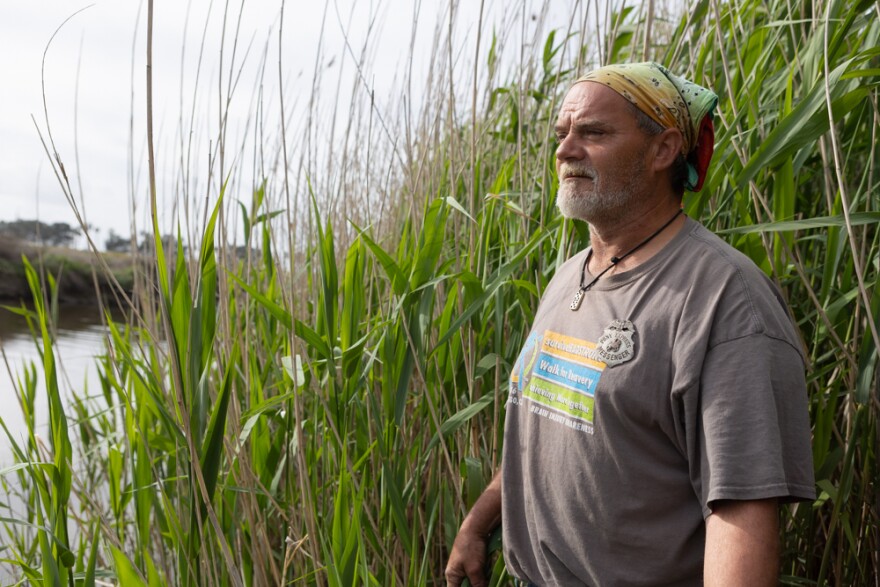
“I have my own little beach here, check this out,” he said. Art put his arms out in front of his face to protect his eyes and pushed through the Spanish cane, following a well-worn path to the water’s edge.
“It’s kinda cool,” Art said, overlooking the water at high tide. “It’s like there’s nobody out here.”
Suddenly, a semi-truck sped by on the roadway above. Almost as if the universe was snapping him back to reality. He felt it, too.
“The only thing is you have to deal with the sound of the freeway,” he said. “The constant rush of the everyday humdrums, all the ants going to work and coming back.”
‘Most people can’t do this’
This year, rainfall in San Diego has exceeded the annual average, including one historic and harrowing day in January.
Tim Moore said he remembers that day well. The 60-year-old man said he was waist deep in fast-moving water, pulling others from the island to the shore. So far this year, he said flooding has carried his tent away three times.
“I was just going cuckoo over it,” he said. He did, however, manage to save his guitar — a 30th birthday gift from his parents who have since passed.
Moore has been living on and off the island for the past 14 years, and during that time, he’s seen the number of people living in the riverbed rise and fall. Most come to the island to lay low, and stay out of sight of people and police. That’s what brought him here.
“I’ve been thrown in jail seven times for what they call illegal lodging. Seven times,” Moore said. “Stay in jail for three days, see a judge and out you go.”

When police ramp up enforcement efforts, it’s common for people without housing to trickle down into the riverbed and tributary canyons, said Sarah Hutmacher, chief operating officer of the San Diego River Park Foundation. The nonprofit coordinates with the river’s many public and private landowners to advocate, collaborate and shine a light on issues impacting the river.
Most people who choose to live along the San Diego River have been experiencing homelessness for several years — Hutmacher and her team think the average is more than 10.
Three times a year, the River Park Foundation counts people who call this waterway home. The most recent census shows a decrease compared to the same time last year, Hutmacher said. Some have left after recent enforcement efforts along the river, others left with help finding temporary or long-term housing, and still others were driven out by the historic flooding.
“It’s very, very common that when we see flooding, people are just absolutely forced to leave,” she said. “Their tents are underwater, they lose all their stuff, they have to relocate to some place, and that doesn’t necessarily mean they’ll stay away.”
Folks eventually make their way down there after being pushed out of other communities, and they know where they can settle down to avoid enforcement. Lately, Hutmacher said, one of those areas has been the island.
Ricky “Stony” Jenkins said he has been living on and off the island for seven years, and he knows it’s just outside of local law enforcement’s reach. He said he recently came back after losing all of his belongings in an encampment sweep, including his parents’ ashes.
“I’m too old to be out here, I really am,” Jenkins said. “Most people can’t do this.”
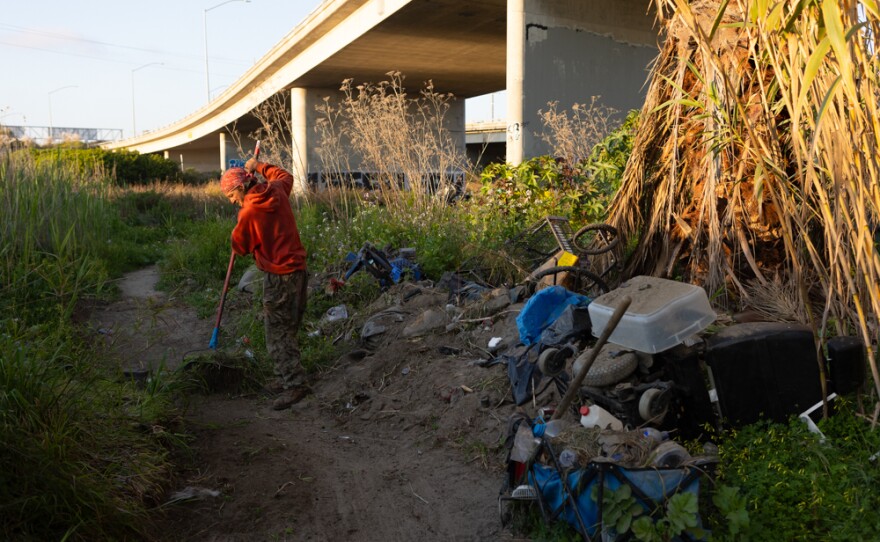
The 60-year-old man said he returned this time with only the clothes on his back.
“That’s all I had, and then my friends came together and they helped me out,” Jenkins said. “Out here, man, we all get along, we all help each other. We’re all like a family. I’ve known most of these people almost 15 years.”
Like in any community, there can be agitators and thievery on the island — some of which coming from people who don’t even live there. But when someone is in need, residents come together to help, whether it’s acquiring a new tent or securing food, water or clothing.
On the island, residents look to Moore as a seasoned leader. But he said he wants out. He’s ready for housing and finds hope in the fact that roughly a dozen people have already left the island with keys to a new home. As with everyone else who spoke with inewsource, Moore said he would jump on the opportunity for something better.
“I would rather have my own house or apartment and a job, and be back to normal,” Moore said. “I don’t want to die out here.”







